Related Research Articles
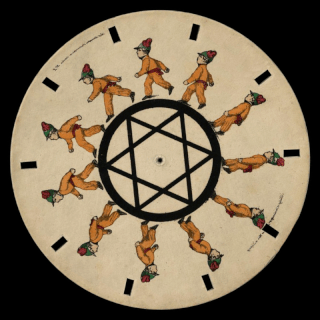
The phenakistiscope was the first widespread animation device that created a fluent illusion of motion. Dubbed Fantascope and Stroboscopische Scheiben by its inventors, it has been known under many other names until the French product name Phénakisticope became common. The phenakistiscope is regarded as one of the first forms of moving media entertainment that paved the way for the future motion picture and film industry. Similar to a GIF animation, it can only show a short continuous loop.
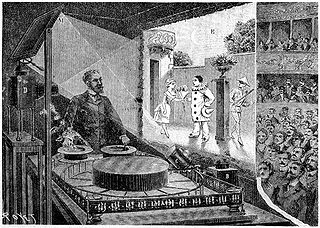
The Théâtre Optique is an animated moving picture system invented by Émile Reynaud and patented in 1888. From 28 October 1892 to March 1900 Reynaud gave over 12,800 shows to a total of over 500,000 visitors at the Musée Grévin in Paris. His Pantomimes Lumineuses series of animated films include Pauvre Pierrot and Autour d'une cabine. Reynaud's Théâtre Optique predated Auguste and Louis Lumière's first commercial, public screening of the cinematograph on 28 December 1895, which has long been seen as the birth of film.

The Man with the Rubber Head, also known as A Swelled Head, is a 1901 French silent trick film by Georges Méliès. The film stars Méliès himself as an apothecary who blows a copy of his own head up to enormous dimensions, but who is unable to get his assistant to perform the stunt as expertly. The special effect of the inflated head, made with a novel combination of purpose-built moving equipment and multiple exposures, evokes the modern close-up and enjoys an iconic place among Méliès's works.
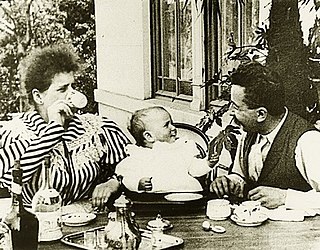
Repas de bébé is a 1895 French short black-and-white silent actuality film photographed by Louis Lumière and showing his brother Auguste Lumière and Auguste's wife Marguerite feeding their infant daughter, Andrée Lumière.

François Arnold Reichenbach was a French film director, cinematographer producer and screenwriter. He directed 40 films between 1954 and 1993.

The Cinémathèque québécoise is a film conservatory in Montreal, Quebec, Canada. Its purpose is to preserve, document, film, and television footage and related documents and artifacts for future use by the public. The Cinémathèque's collections include over 35,000 films from all eras and countries, 25,000 television programmes, 28,000 posters, 600,000 photos, 2,000 pieces of historical equipment, 15,000 scripts and production documents, 45,000 books, 3,000 magazine titles, thousands of files, as well as objects, props, and costumes. The conservatory also includes a film theatre, which screens rarely seen films and videos.

The Museum of Precinema is a museum in the Palazzo Angeli, Prato della Valle, Padua, Italy, related to the history of precinema, or precursors of film. It was created in 1998 to display the Minici Zotti Collection, in collaboration with the Comune di Padova. It also produces interactive touring exhibitions and makes valuable loans to other prestigious exhibitions such as 'Lanterne magique et film peint' at the Cinémathèque Française in Paris and the Museum of Cinema in Turin.

The Cinémathèque suisse, formerly the Archives cinématographiques suisses, is a Swiss state-approved non-profit foundation headquartered in Lausanne. It aims to collect, protect, study and present film archives. The Swiss Cinematheque has its archives in Penthaz and a branch office in Zürich.
A list of books and essays about Georges Méliès:
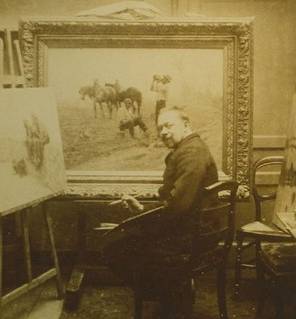
Georges Philibert Charles Maroniez was a French painter, specializing in landscapes with figures.
Cinderella or the Glass Slipper is a 1913 French silent film directed by Georges Méliès, based on the fairy tale by Charles Perrault.

Jean Douchet was a French film director, historian, film critic and teacher who began his career in the early 1950s at Gazette du Cinéma and Cahiers du cinéma with members of the future French New Wave.

Barrier-grid animation or picket-fence animation is an animation effect created by moving a striped transparent overlay across an interlaced image. The barrier-grid technique originated in the late 1890s, overlapping with the development of parallax stereography (Relièphographie) for 3D autostereograms. The technique has also been used for color-changing pictures, but to a much lesser extent.
Giorgina Madìa was an Italian physicist and electrical engineer, specializing in electrical communications, and a member of the Italian resistance during World War II.
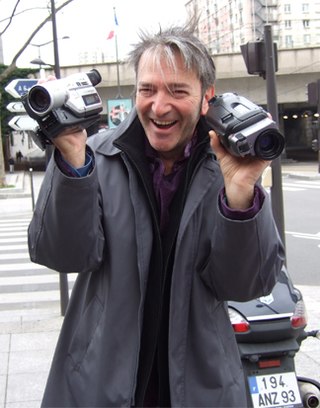
Jean-Claude Mocik, was born on February 9, 1958, in Livry Gargan. He is a filmmaker, video director, a director and teacher.

Content in this edit is translated from the existing French Wikipedia article at fr:Cinémathèque de Saint-Étienne; see its history for attribution.
Pierre François Antoine Molteni, also known as Antoine Molteno or François Molteno, was a manufacturer and trader in optical instruments and other scientific equipment, who built the first devices used by Louis Daguerre and founded the "Maison Molteni" in Paris.
An anorthoscope is a device that demonstrates an optical illusion that turns an anamorphic picture on a disc into a normal image by rotating it behind a counter-rotating disk with four radial slits. It was invented in 1829 by Belgian physicist Joseph Plateau, whose further studies of the principle led him to the 1832 invention of a stroboscopic animation that would become known as the phénakisticope.
Optical toys form a group of devices with some entertainment value combined with a scientific, optical nature. Many of these were also known as "philosophical toys" when they were developed in the 19th century.
The Cinémathèque Méliès – Les Amis de Georges Méliès is a non-profit French organisation created in 1961 to locate, gather, preserve and promote the work of Georges Méliès and restore a French cultural heritage which, in 1945, was considered lost. The rediscovered work is promoted through lectures, "ciné-concerts" as in the early days of cinema , exhibitions, publications, a documentary and DVDs. So far, the association has managed to collect about 200 films, 145 of which were given to the Cinémathèque française.
References
- ↑ Nature. Dunod. 1901.
- ↑ "Caméra réversible film 21 mm (CNC-AP-12-1124) - Collection - Catalogue des appareils cinématographiques - La Cinémathèque française". www.cinematheque.fr.
- ↑ Raymond Fielding (1983). A Technological History of Motion Pictures and Television. University of California Press. pp. 130–. GGKEY:6ZBS232TCDQ.
- 1 2 Nansouty (1894). La vie scientifique.
- ↑ Progresso fotografico. Progresso. 1901.
- ↑ Carnet-agenda du photographe à l'usage des amateurs et des professionnels, 1900-1901. J.B. Baillière et fils. 1902.
- ↑ "projecteur de film 21 mm à encoches latérales (CNC-AP-96-49) - Collection - Catalogue des appareils cinématographiques - La Cinémathèque française". www.cinematheque.fr.